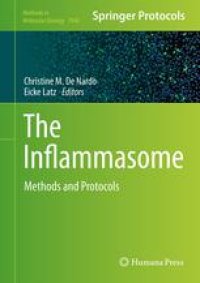
Ebook: The Inflammasome: Methods and Protocols
Author: Mareike Schnaars Hannes Beckert Annett Halle (auth.) Christine M. De Nardo Eicke Latz (eds.)
- Tags: Immunology, Cytokines and Growth Factors
- Series: Methods in Molecular Biology 1040
- Year: 2013
- Publisher: Humana Press
- Edition: 1
- Language: English
- pdf
Inflammasomes have a seemingly simple architecture. A sensor molecule of the NLR or PYHIN protein family recruits the common adapter molecule apoptosis-associated speck-like protein containing a CARD (ASC). Even so, inflammasome activation is highly regulated at multiple steps and precise details of how inflammasomes are activated at the molecular level remain largely unknown. In The Inflammasome: Methods and Protocols, expert researchers in the field detail methods and protocols to study multiple aspects of inflammasome function. These methods include the generation of inflammasome stimuli, perturbance of cellular homeostasis, assessment of ASC speck formation, monitoring of caspase-1 activity and processing, activation of IL-1β cytokines, and analysis of inflammasome assembly. Written in the highly successful Methods in Molecular Biology series format, chapters include introductions to their respective topics, lists of the necessary materials and reagents, step-by-step readily reproducible laboratory protocols, and key tips on troubleshooting and avoiding known pitfalls.
Inflammasomes have a seemingly simple architecture. A sensor molecule of the NLR or PYHIN protein family recruits the common adapter molecule apoptosis-associated speck-like protein containing a CARD (ASC). Even so, inflammasome activation is highly regulated at multiple steps and precise details of how inflammasomes are activated at the molecular level remain largely unknown. In The Inflammasome: Methods and Protocols, expert researchers in the field detail methods and protocols to study multiple aspects of inflammasome function. These methods include the generation of inflammasome stimuli, perturbance of cellular homeostasis, assessment of ASC speck formation, monitoring of caspase-1 activity and processing, activation of IL-1? cytokines, and analysis of inflammasome assembly. Written in the highly successful Methods in Molecular Biology series format, chapters include introductions to their respective topics, lists of the necessary materials and reagents, step-by-step readily reproducible laboratory protocols, and key tips on troubleshooting and avoiding known pitfalls.
Inflammasomes have a seemingly simple architecture. A sensor molecule of the NLR or PYHIN protein family recruits the common adapter molecule apoptosis-associated speck-like protein containing a CARD (ASC). Even so, inflammasome activation is highly regulated at multiple steps and precise details of how inflammasomes are activated at the molecular level remain largely unknown. In The Inflammasome: Methods and Protocols, expert researchers in the field detail methods and protocols to study multiple aspects of inflammasome function. These methods include the generation of inflammasome stimuli, perturbance of cellular homeostasis, assessment of ASC speck formation, monitoring of caspase-1 activity and processing, activation of IL-1? cytokines, and analysis of inflammasome assembly. Written in the highly successful Methods in Molecular Biology series format, chapters include introductions to their respective topics, lists of the necessary materials and reagents, step-by-step readily reproducible laboratory protocols, and key tips on troubleshooting and avoiding known pitfalls.
Content:
Front Matter....Pages i-xi
Back Matter....Pages 1-8
....Pages 9-18